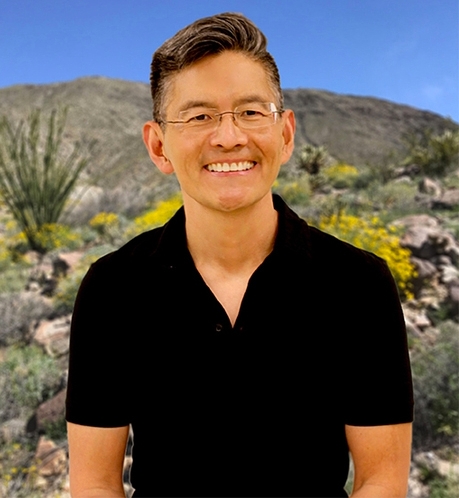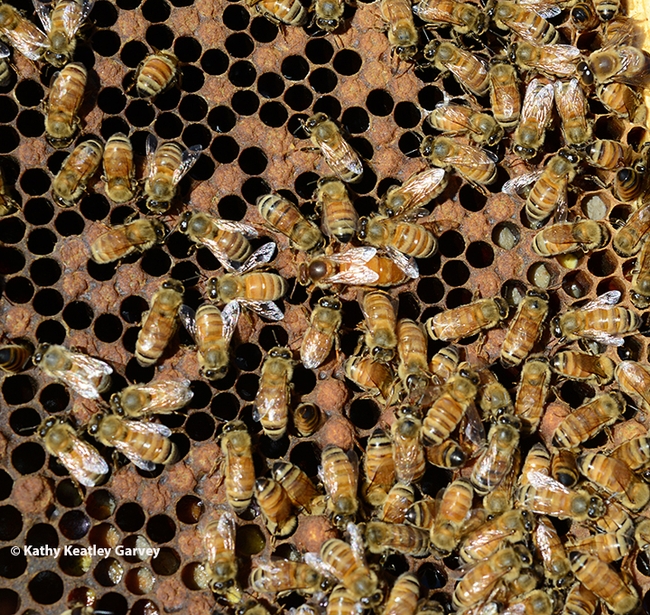
You're dancing in the dark, on a small, crowded dance floor with lots of obstacles, and you're trying to communicate to other foragers where that great resource is. You're relating the direction, distance, and quality of the resource (pollen, nectar, propolis, or water) so that they too, can find it, collect it and return it to the hive.
Can you do that? And also perform other communications, like letting the colony know where a good nesting site is?
No?
Want to learn more about honey bee communication?
Enter bee biologist James Nieh, a professor and an associate dean at UC San Diego. He'll present a seminar, hosted by the UC Davis Department of Entomology and Nematology, at 4:10 p.m., Monday, Dec. 4 in Room 122 of Briggs Hall. His seminar, "Danger, Dopamine, and Dance: New Insights from the Magic Well of Honey Bee Communication," also will be on Zoom. The Zoom link:
https://ucdavis.zoom.us/j/95882849672
Nieh, who is a faculty member of the Section of Ecology, Behavior, and Evolution, Division of Biological Sciences, and associate dean of Biological Sciences, has studied honey bee communication for decades.
"Karl von Frisch referred to the waggle dance as the 'magic well' for the insights that it provides not only on honey bees, but on the general cognitive complexity that social insects are capable of," he writes in his abstract. "New research demonstrates that the neurotransmitter, dopamine, the 'pleasure molecule' plays a similar hedonic role in honey bees as it does in many vertebrates, regulating the perception of danger and the anticipation of food rewards as revealed in the excitatory waggle dance and the associated, inhibitory stop signal. I will also discuss new data showing that the honey bee waggle dance is partially learned and has elements that may be culturally transmitted. Together, these findings, demonstrate that the waggle dance can teach us a great deal about shared cognitive mechanisms and the importance of social learning across taxa."
In an article, "Social Signal Learning of the Waggle Dance in Honey Bees," published in Science in March, 2023, Nieh and his research team showed that "correct waggle dancing requires social learning. Bees without the opportunity to follow any dances before they first danced produced significantly more disordered dances with larger waggle angle divergence errors and encoded distance incorrectly. The former deficit improved with experience, but distance encoding was set for life. The first dances of bees that could follow other dancers showed neither impairment. Social learning, therefore, shapes honey bee signaling, as it does communication in human infants, birds, and multiple other vertebrate species. that correct waggle dancing requires social learning. Bees without the opportunity to follow any dances before they first danced produced significantly more disordered dances with larger waggle angle divergence errors and encoded distance incorrectly. The former deficit improved with experience, but distance encoding was set for life. The first dances of bees that could follow other dancers showed neither impairment. Social learning, therefore, shapes honey bee signaling, as it does communication in human infants, birds, and multiple other vertebrate species."
Nieh received his bachelor's degree from Harvard University in 1991 and his doctorate from Cornell University in 1997. He completed a postdoctoral fellowship funded by NSF-NAT0 (National Science Foundation, North Atlantic Treaty Organization) at the University of Würzburg, Germany. He served as a Harvard Junior Fellow from 1998-2000.
Seminar coordinator is Brian Johnson, associate professor, UC Davis Department of Entomology and Nematology. For Zoom technical issues, he may be reached at brnjohnson@ucdavis.edu. The list of seminars is posted here.
Attached Images:
